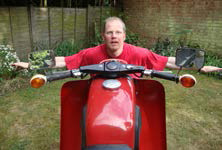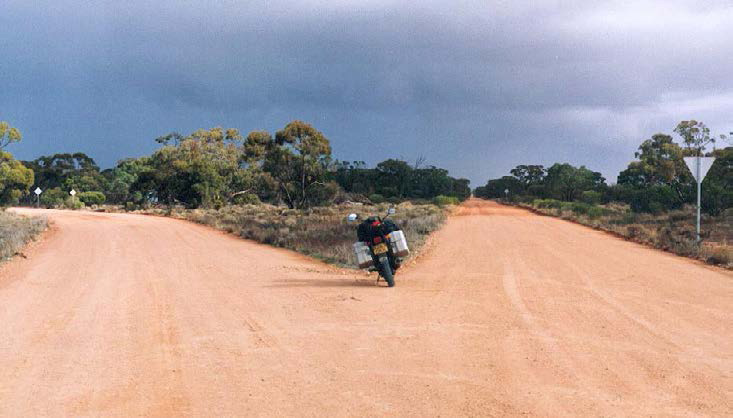
Which Way Now?
It’s something to ponder: Where’s the Bike Industry going? Chasing a GP dream or embracing environmentalism? Are the marketing men leading, or are consumers demanding change? Is legislation pulling the rug from beneath the engineers, or actually shaping their design parameters? And where do the attitudes of policy makers and ideologues fit in?
Yes, they’re the sort of questions that amateur philosophers regularly tackle after a couple of ales down the local debating chamber, but do any of them matter? I feel that if we are to stem the haemorrhaging and address the contraction of an industry we love, they do matter.
Fashions come and go of course, so many riders who swore they’d only buy a sports machine, now realise how very comfortable an adventure bike can be and just how suitable it actually is for them. But are these the same people who can no longer get into their one-piece leathers and who think not of setting up the next bend, but setting up a cup of cocoa to stop their wrists aching? We’re not getting younger, maybe some of us are just buying bikes that fit.
It’s chicken and egg with the marketing men and while the good ones can create desire, think of the styles that have been led by riders; the streetfighter or the ‘factory’ custom, and now the retro and bobber. The factories are as happy to jump in and follow a trend as they are to try and set one.
It’s difficult for an industry to be taken seriously by the green lobby, when for so long it has defined itself as leisure pursuit, and although riders have often said they want fuel efficiency, they’ve been offered the Royal Enfield but they’ve chosen 1250 Bandits. We’re a fickle bunch.
So now that Honda has taken the plunge with the NC700 and new CB500 range, what’ll it do for sales and will every manufacturer follow? Of course they’ll have to, as new emissions laws are phased in over the rest of the decade, but will we buy what they make? As we get even older and frailer, will we opt for practical bikes like that and actually use them, or will it be too much hassle getting dressed? Will we be scared our dicks will look too small on sensible bikes? And will we simply get in the car if it looks like rain ‘cos it’s more convenient’? Ah yes. Convenience.
The industry mind-set seems to be that there is a type of rider that must be satisfied and if they’re used to screaming fours and performance, there’s no way they’ll change. But that’s an attitude that misses one thing: Those who don’t ride yet. Maybe they are the most important thing. There’s no reason why they aren’t relevant. They are consumers too. Ah, you shout, ‘but they aren’t riders!’ And neither were you until you started. For one reason or another, your interest in riding was piqued.
Then again, maybe you’re a petrol head and already predisposed to riding a bike, in which case you may sneer at the eco-sound NC700. And now we see the ever-decreasing circle close.
There are 36 million adults in the UK of sound enough mind to be granted a driving licence and only 1.5million (or thereabouts) currently road-registered bikes. There doesn’t seem to be any desire to encourage all these non-bike users out of their cars. No-one is making biking convenient.
Much of what the bike industry offers isn’t terribly practical for non petrolheads. Bikes for the most part have exposed chains that require constant attention but no centre stand to make the job any easier. And where do you put your shopping, briefcase, tools, and sandwiches? You think I’m missing the point though ‘cos bikes are all about fun right? So why can’t fun be an everyday thing? If your car isn’t fun, why keep using it? Did the bike clock up 12,000 miles last year, or was it the car?
The scooter was a revelation in the 50s, it considered a different user group and they sold like hot cakes. They still lead the way in sales by volume, and there’s somewhere to put the lock and chain you need to carry because the local authorities don’t want to make riding convenient either. If they did, there’d be signs directing riders to secure bike parking, where you could actually use that lock and chain; and that parking would be somewhere you’d want it – there may even be CCTV. Hell there’s enough of it about; it would be good if it was used for something useful.
These local councils who complain about congestion on the one hand and their city centres dying on the other, could sort both problems if they made biking convenient. Two wheels don’t take up much space in use, or when parked. Two modern green wheels don’t congest or pollute much at all. Granting bikes access to priority lanes would encourage more drivers to get out of their cars and give it a go, which would encourage people to visit and revitalise city centres. Ever visited a mainland European town? Notice anything? That’s right there are two-wheelers parked just about everywhere?
National government could make biking more convenient by rewarding the sensible and socially responsible choice of two wheels by removing road tax.
Enlightened public policy, whether local or national, could ensure bike convenience. It could improve safety for all, air quality for all and if the bike industry supplied the goods, machinery for all.
But who wants to invest? Well, precious few it would appear, within or without the bike industry. No-one wants to look at a bigger picture. There is no unity, no clear vision and one-upmanship seems to be the only game in town.
Riders can and do adapt to bikes that have been engineered to meet ever stricter criteria. Some riders continue to piss-off other road users through anti-social behaviour, while claiming a right to be left alone to do so. It’s much easier to make reactive laws when you’re chasing votes than it is to be proactive and hear reasons to encourage bikes. Will we learn? Do we even want biking to be convenient so we can have fun every day? Should our industry campaign locally to create convenience and stop the rot, or does it need riders to do that for it? Where’s the unity?
Big questions and decreasing sales.
Which way now?
Paddy Tyson



This is or, rather these are the most pressing questions at present or, are they questions that have always been there? Its just with better communication channels more of us are starting to join the dots.
Personally I believe that may be Honda tend to be the bravest or most informed, not ever sure which. After all is it nit Honda that have set trends since their emergence? Even now the commercially unpopular DN1, did that not more into the latest offerings? The DN1 looked ahead of its time but was it Honda just evaluating the drive train and testing the water for the future PTW?
Then there is the question of legislation driving designs or shrinking the industry. Whilst the motorcycle and scooter industry is small in comparison to the car industry, it is still a major employer around the world. Plus in the 3rd world and emerging countries the motorcycle is a vital method of transport. So the legislative bodies would have a very hard time if they pushed on with vision Zero. So, my question, is there a high level collaboration that shapes what we ride?
Good comment Simon. Paddy is half way up the Himalayas at the moment, but I’m sure that he’ll respond when he returns.
Ed
Simon, I didn’t mean to, but I appear to have written an essay in response…
I believe there is a world of difference between the design (and any collaboration thereof) of motorcycles, and the Vision Zero ideas which are generally attributed to Claes Tingvall in Sweden.
Granted, both may aim for casualty reduction, but for one it’s central, the other it’s peripheral and they are not absolutely related. The vision zero idea as initially introduced in Sweden and later adopted by other countries, such as Norway, has had limited success and driving in Sweden can now make you run the risk of falling asleep as even single carraigeway roads are being divided by wire rope fencing to remove any possibility of vehicles straying from their governemnt ordained path. What this leads to is traffic moving at the speed of the slowest vehicle, a mad rush and last minute braking when there is an approved overtake section and congestion if a vehicle breaks down. Unintended consequences of course, of a
Vision vwhich has 3 fundamental principles (to quote):
1. It’s not necessarily the accidents that are to be eradicated, but rather the consequences of the accidents that are going to be reduced. ‘A mistake should not be punishable by death’.
2. The human body has some tolerance to outer force; this tolerance should dimension the design of the road transport system, for example when constructing roads, vehicles and when passing
legislation. Special care should be taken of the least protected.
3. The system designers must take a larger responsibility for road safety. This means that we who are using the system have the right to make demands, but that also we need to follow the rules and
accept some restrictions. Together we create road safety.”
Interestingly, in 1997 when VZ was introduced, there was no thought of motorcycle inclusion. All the infrastructural development employed can have detrimental effects on bikes and infact be negative, increasing injury, or the possibility of such.
As bikes weren’t really considered, so the prevailing thought was that they should best be eliminated, but as rider training increased and the riding community took responsibility for itself, motorcycle casualties fell dramatically despite the more damaging environment, illustrating yet again that education works much better than legislation. Even Mr Tingvall has since praised Swedish motorcycling and said he is delighted and surprised at the advances made without VZ intervention.
A large proportion of Sweden’s continuing motorcycle injury and fatality stats, are due to those who don’t even have a licence and should not thus be classed as motorcyclists. They are persistent law breakers in other fields too, so their behaviour should not influence transport safety policy.
But this is all quite at odds with the idea of legislating vehicle design.
There are global plans for motorcycle design which encompass emissions and passive safety controls.
You can see an overview here
http://www.unece.org/trans/main/wp29/wp29regs41-60.html
The Type Approval regulations that we see in Europe (the most recent of which was passed in November last year) are simply a part of working towards that.
Safety is of course a catch all phrase and one which is often used politically to cover a multitude of sins or to blur discussion or refute argument. Who after all can’t be against safety? Who wants to see the little children being killed? Or the one that we so often hear ‘if it saves one life it must be worth it…’
Take for example the Roadworthiness Regulation which is moving through the EU legislative machine at the minute and will pass Committee stage on 30th May; there is no statistical evidence to introduce what is being proposed, but surely a motorcycle with no MoT is inherently unsafe?
Well, no actually. There is no difference in motorcycle accident causation between countries with and without an MoT or equivelent. This legislation is being driven by the private interests of the Roadworthiness inspection industry, but it does illustrate that huge expenditure can be invested for little discernible gain. The component which most fails and directly causes a bike accident, is the tyre, and checking tyre pressures is a whole lot more efficient at preventing accidents than introducing a pan european testing regime and bureaucratic nightmare.
But you still hear that an MoT is bound to improve safety isn’t it? Well it too has an unintended consequence- that of owners ignoring all their vehiclular maintenance until MoT time and just seeing what it needs to pass.
I digress of course, but the similar issue of diminishing safety returns can be seen within the Type Approval Regulation. Designing cleaner running engines is one thing, and a laudible one, but fitting loads of other passive safety features, like compulsory headlight use, has no justifiable evidence, but does shift onus of blame onto the rider and away from the 3rd party who should have been looking before they pulled out into the main road.
In answer then, to the question ‘is there high level collaboration shaping what we ride?’ YES. But only to a point. Manufacturers are having to work with legislators to achieve political/environmental goals, but often the idealogues pitch an idea and the engineers say they will be able to achieve half that, and so a negotiated outcome is achieved and a time frame for implementation agreed.
This gets us all the thousands of cut out switches that piss us off after a winter’s ride through the salt, but also gets us ABS and cleaner economical engines like that on the NC700.
Remember of course, that the manufacturers will be very happy when the World standard is fully implemented, as they will then just be producing a single machine which can be sold in every market in the world without alteration, which is great for profit.
What’s the topic here? Is it ‘we need new riders’ or is it ‘road safety’?
Let’s talk new riders.
I’ve just come back from a visit to China and it was hugely enlightening. I was in a bike-friendly city, and that taught me one thing: China isn’t a legislative monolith, they have different laws in different regions. This is good. It’s Darwinian. It means that they can test out different systems to see what works best. In the US, they used to believe the same. different laws for different types. Which Is Why The EU Is Such an F*** Bad Idea.
In Ning Bo, real place, population 10 million, about half the city and most of the students go to work by electric scooter. Hardly anyone wears a helmet, except a few building workers who commute with their hard hats on. No-one wears biking gear, the main idea was to wear your anorak backwards. The streets are well surfaced and brightly lit and no-one turns their lights on after dark: no dazzle, and saves the battery. There are no limits to the number of passengers and I regularly saw bikes with mum, dad, and much-loved toddler in the middle, or baby basket on the rack. There were lots of policeman directing traffic and never once did I see a bike rider stopped or hassled. The job of traffic wardens is to watch over the huge free bike parks on most wide streets, and to protect them against thieves or reversing trucks.
Two huge cultural differences, though: no ‘bad boys’, no ‘pretend racers’. No wheelies. No tyre burners. At the traffic lights, they all surge forwards together: no-one’s trying to beat anyone else. I saw no bikes bigger than 400, and cops ride those.
If we want to get more people back on bikes the biggest changes have to be legislative. Ning Bo makes it easy because the laws are easy. Simple as that.
But the reasons why our laws are anti-bike are our own fault. In different ways, ‘bad boy’ culture and ‘racer’ culture has been annoying our legislators since the 1950’s. They treat us as the enemy because we cast ourselves that way. That’s why the latest bike safety advertising tries to persuade people that motorcyclists are actually human.
So if we want to increase the number of new riders, we’ve got to dismantle anti-bike legislation. And to do that, we’ve got to get normal people on our side.
Which is why I wear an open face helmet and smile at people.
Love the topics. I also vote for more riders to prosper and grow the biking community. My wife and I commute daily, regardless of the weather and the car is only used for short distance shopping trips when we do monthly groceries.
We try to promote riding by attending charity bike runs. The NC750X is most definitely our next bike, but also love the adrenaline monster four cylinders such as BMW S1000rr and Honda fireblade. Etc
Balance is the key, I believe. Promote safe driving on public roads and especially in residential and city areas.
Perhaps we need more open racetracks with longer winding stretches, why not redesign the concept of fast paced racing. Racing bikes should be more than a spectators sport, why not make it more accessible in a controlled environment and keep death off our roads?